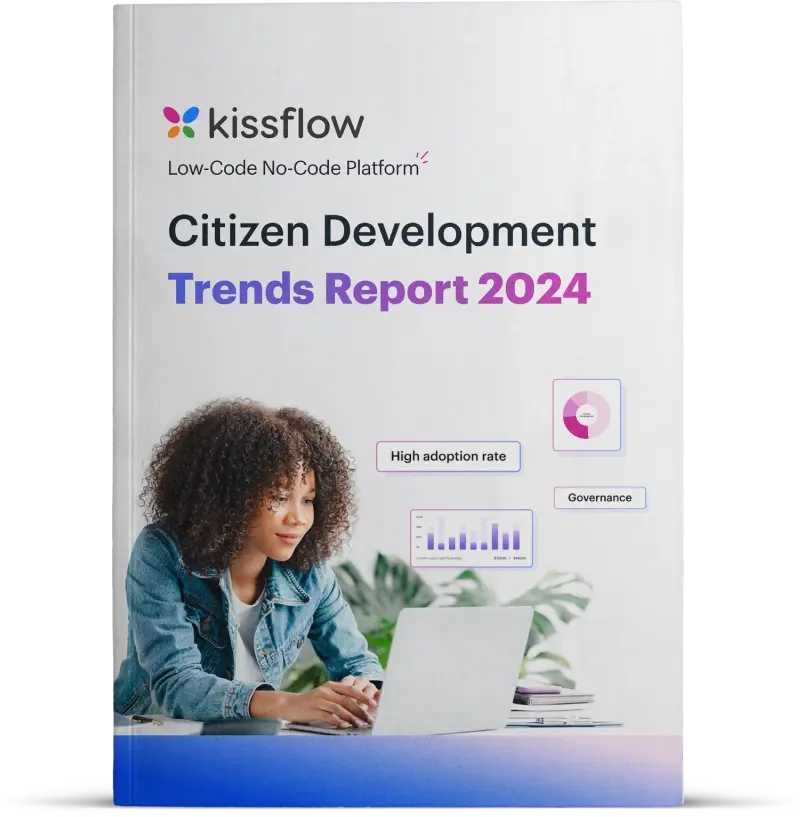
- >
- Oil and Gas>
- Automating Quality Control in Oil and Gas
Automating Quality Control in Oil and Gas: Leveraging AI and Low-Code Applications
Team Kissflow
Updated on 11 Jun 2025 • 8 min read
The oil and gas refining industry stands at a crucial intersection where operational excellence meets regulatory compliance. As refineries face mounting pressure to optimize production while maintaining stringent quality standards, quality control automation in refining has emerged as a game-changing solution. Modern refineries increasingly turn to AI-powered systems and low-code platforms to revolutionize their quality assurance processes, creating more efficient, accurate, and cost-effective operations.
For refining operations specifically, McKinsey research shows that digital solutions in the oil and gas industry could cut costs by up to 25%[1] per barrel, making the business case for automation compelling.
The importance of quality control in refining operations
Product consistency and regulatory compliance form the cornerstone of successful refining operations. In an industry where even minor deviations can result in significant financial losses and safety hazards, rigorous inspection and reporting processes are not just beneficial—they're essential for maintaining operational standards and market competitiveness.
Traditional manual quality control processes present significant challenges that can compromise both efficiency and safety. These legacy systems often delay issue detection, creating cascading problems throughout the production cycle. The lack of real-time traceability in manual processes makes it difficult to identify root causes quickly, leading to extended downtime and increased operational risks.
The stakes are particularly high in refining operations, where quality control directly impacts product specifications, environmental compliance, and worker safety. By automating processes, oil and gas companies can standardize operations, reduce errors, and make data-driven decisions in real time, transforming how refineries approach quality assurance.
Effective quality control automation in refining enables organizations to move from reactive to proactive quality management. Instead of discovering issues after products have been processed, automated systems can identify potential problems early in the production cycle, preventing costly rework and ensuring consistent product quality that meets both internal standards and regulatory requirements.
Automating inspection workflows with low-code tools
Low-code platforms have revolutionized how refineries approach quality control digitization. These platforms, exemplified by solutions like Kissflow, enable the transformation of traditional paper-based inspection forms into dynamic digital workflows for sampling, testing, and result recording. This digital transformation eliminates the bottlenecks and errors associated with manual data entry while providing real-time visibility into quality metrics.
The automation in the oil and gas industry has particularly benefited from low-code solutions that enable real-time data entry via mobile and tablet devices during shift-based inspections. Field technicians can now capture inspection data directly at the point of collection, improving both accuracy and timeliness while reducing the administrative burden on quality control teams.
Modern low-code platforms offer intuitive interfaces that allow refining companies to quickly create and deploy digital inspection workflows without extensive programming knowledge. This democratization of technology enables quality managers to adapt processes rapidly as requirements evolve, ensuring that QC automation in oil and gas remains aligned with operational needs.
The benefits of digitizing inspection workflows extend beyond simple data collection. These systems automatically validate entered data, flagging inconsistencies or values that fall outside acceptable parameters. This immediate feedback helps prevent errors from propagating through the system, maintaining the integrity of quality control processes.
Integration capabilities built into low-code platforms allow seamless connectivity with existing enterprise systems, ensuring quality data flows smoothly between different operational areas. This interconnectedness supports comprehensive quality management approaches that span from raw material intake to finished product release.
Capturing non-conformances and triggering corrective actions
Automated quality control systems excel at identifying and managing non-conformances through sophisticated rule-based engines. These systems can automatically flag deviations based on predefined test parameters, ensuring swift identification of quality issues before they impact production or compromise safety standards.
The power of automation systems in the oil and gas industries becomes particularly evident in how they handle corrective action workflows. When non-conformances are detected, automated systems can immediately route corrective action tasks to appropriate quality and operations teams, complete with escalation paths to ensure timely resolution and prevent recurring issues.
Advanced workflow automation capabilities facilitate the automatic routing of non-conformance reports and assignment of corrective actions with built-in tracking mechanisms. This ensures accountability throughout the resolution process while maintaining comprehensive audit trails for compliance purposes. The system can track response times, resolution effectiveness, and trend patterns to continuously improve quality control processes.
The integration of artificial intelligence in these systems enables predictive analytics that can anticipate potential non-conformances before they occur. By analyzing historical data patterns, AI algorithms can identify subtle indicators that precede quality issues, allowing proactive interventions that prevent problems rather than simply reacting to them.
Automated escalation protocols in field operations management ensure that critical quality issues receive the right attention based on severity and impact. This intelligent routing system optimizes resource allocation and ensures no quality concerns fall through the cracks—supporting the high standards required in refining operations.
"By facilitating the efficient flow of information across the entire spectrum of operations, you can help foster collaboration, enhance decision-making processes and provide a holistic view of your organization's data landscape."
- Shashidhar Reddy Keshireddy, Director of Data Integration Specialist at CEPTUA IT INC
Applying AI models for anomaly detection and trends
Artificial intelligence has transformed quality control from a reactive discipline to a predictive science. AI models can analyze vast amounts of historical inspection data to detect subtle deviations from quality norms that might escape human observation. This capability enables refineries to identify patterns and trends that indicate potential quality issues before they manifest as actual problems.
The predictive capabilities of AI in refinery process automation allow operations teams to anticipate quality patterns that may lead to non-conformance events. By analyzing factors such as temperature variations, pressure fluctuations, feedstock characteristics, and processing conditions, AI systems can forecast quality outcomes and recommend preventive actions.
Machine learning algorithms continuously improve their accuracy by learning from new data inputs and outcomes. This adaptive capability means that AI-powered quality control systems become more effective over time, providing increasingly precise predictions and recommendations that enhance overall operational efficiency.
77% of organizations are now investing in AI to optimize quality assurance processes, demonstrating the widespread recognition of AI's value in quality control applications. For refining operations, this investment translates into reduced quality incidents, improved product consistency, and enhanced operational reliability.
Advanced AI models can correlate quality data with external factors such as weather conditions, supply chain disruptions, and equipment performance metrics. This holistic approach to quality prediction enables refineries to implement comprehensive quality management strategies that address both internal and external influences on product quality.
Real-time dashboards and compliance reporting
Real-time visibility into quality metrics has become essential for modern refining operations. Advanced dashboard systems display inspection status, non-conformance report (NCR) counts, and resolution times across different units and shifts, providing managers with immediate insights into quality performance trends and operational efficiency.
The value of automated quality assurance in oil and gas extends beyond operational metrics to encompass comprehensive compliance reporting. Digital logs maintained by automated systems create detailed audit trails that support certifications and regulatory submissions, ensuring that refineries can demonstrate compliance with industry standards and regulatory requirements.
Modern reporting systems offer customizable dashboards that allow quality managers to monitor key performance indicators specific to their operational priorities. These dashboards can display real-time data on product specifications, process variations, equipment performance, and quality trends, enabling data-driven decision-making that improves overall operational effectiveness.
Integration with enterprise resource planning (ERP) systems ensures that quality data flows seamlessly into broader business intelligence platforms. This connectivity enables comprehensive analysis of quality impacts on production costs, customer satisfaction, and regulatory compliance, supporting strategic decision-making at the executive level.
Advanced analytics capabilities built into modern dashboard systems can identify correlations between quality metrics and operational parameters that might not be immediately obvious. These insights enable refineries to optimize processes for both quality and efficiency, maximizing the return on investment in quality control automation.
Streamlining QC with low-code technology for agility, governance, and collaboration
The dynamic nature of refining operations requires quality control systems that can adapt quickly to changing requirements. Low-code platforms empower quality teams to modify processes without extensive IT involvement, ensuring that quality control automation in refining remains responsive to operational needs while maintaining system integrity and security.
The benefits of QC automation in petroleum refining are enhanced when quality managers can update workflows as requirements evolve. Low-code platforms provide this agility while ensuring the IT team maintains control over critical aspects such as data security, system access, and integration with central compliance systems.
By incorporating automative practices, companies can increase productivity, decrease costs, and provide greater safety and convenience for personnel, particularly in remote refining locations where traditional quality control approaches may be challenging to implement effectively.
Modern low-code platforms offer robust security features that meet the stringent requirements of oil and gas operations. These platforms provide role-based access controls, data encryption, and comprehensive audit trails that ensure quality control processes remain secure while enabling the flexibility needed for operational excellence.
Collaboration features built into low-code platforms facilitate effective communication between different teams involved in quality control processes. These tools enable quality managers, operations staff, maintenance teams, and regulatory compliance personnel to collaborate seamlessly, sharing information and coordinating activities supporting comprehensive quality management.
The governance capabilities of enterprise-grade low-code platforms ensure that quality control processes comply with industry standards and regulatory requirements. These systems provide version control, change management, and approval workflows that maintain process integrity while enabling continuous improvement initiatives.
Examples of automation systems in the oil and gas industries
Leading refineries worldwide have implemented various automation systems that demonstrate the practical applications of quality control automation. These implementations showcase how industrial automation in oil and gas can transform traditional quality assurance processes into efficient, reliable, and cost-effective operations.
Process optimization through QC automation in oil and gas has been demonstrated in applications ranging from crude oil analysis to finished product testing. Automated sampling systems ensure representative samples are collected consistently, while automated testing equipment provides rapid, accurate analysis of key quality parameters such as octane rating, sulfur content, and distillation characteristics.
Advanced automation systems integrate multiple quality control functions into cohesive workflows from raw material receipt to product shipment. These comprehensive systems ensure that quality standards are maintained throughout the entire refining process, providing continuous monitoring and control that prevents quality issues from developing.
The implementation of automated quality control systems has enabled refineries to achieve significant improvements in operational efficiency and product quality. Automated refinery equipment can be used in almost every operation, from exploration and drilling to production and refining, to enhance efficiency, productivity, and throughput, demonstrating the broad applicability of automation technologies across refining operations.
Integration with advanced process control systems enables quality control automation to influence production parameters in real-time, automatically adjusting process conditions to maintain optimal product quality. This closed-loop approach to quality control represents the pinnacle of automated quality assurance in oil and gas operations.
What’s next for refining operations
Quality control automation in refining represents a fundamental shift from traditional quality assurance approaches to intelligent, predictive systems that enhance both operational efficiency and product quality. The integration of AI technologies and low-code platforms has made sophisticated quality control capabilities accessible to refineries of all sizes, enabling them to compete effectively in an increasingly demanding market.
The statistical evidence supporting automation adoption is compelling. The Refining Industry Automation and Software Market is growing at a CAGR of 3%[2] over the next 5 years, indicating sustained investment in these technologies across the industry. This growth reflects the recognition that automated quality control systems provide measurable returns through improved efficiency, reduced costs, and enhanced product quality.
Platforms like Kissflow help accelerate this shift by enabling quality teams to digitize inspections, automate workflows, and maintain full governance without heavy IT reliance. With Kissflow’s low-code approach, refineries can quickly build and adapt quality control applications, whether for non-conformance tracking, audit readiness, or compliance reporting, while keeping IT in control of integration and security.
As refineries continue to face pressure to optimize operations while maintaining stringent quality standards, the role of automation will only become more critical. Organizations that adopt flexible, scalable platforms like Kissflow today will be better positioned to meet the challenges of tomorrow's refining industry, achieving the operational excellence and competitive advantage that quality control automation provides.
The future of refining lies in the intelligent integration of human expertise with automated systems that amplify capabilities while reducing risks. By implementing comprehensive quality control automation strategies with the right platform, refineries can achieve the dual objectives of operational excellence and regulatory compliance, ensuring sustainable success in an evolving industry landscape.
FAQ's - Quality Control Automation in Oil and Gas
1. What is automation in the oil and gas industry?
Automation in the oil and gas industry refers to the use of advanced technologies, including sensors, control systems, artificial intelligence, and robotics, to perform tasks that were traditionally done manually. This includes everything from exploration and drilling operations to refining processes and quality control procedures.
2. How does automation enhance quality control in refining processes?
Automation enhances quality control by providing continuous monitoring, real-time data analysis, and immediate response to quality deviations. Automated systems can detect quality issues faster than manual processes, implement corrective actions automatically, and maintain comprehensive records for compliance and analysis purposes.
3. What technologies are used for quality control automation in oil refineries?
Key technologies include AI-powered analytics platforms, low-code development tools, automated sampling and testing equipment, real-time monitoring systems, and integrated dashboard solutions. These technologies work together to create comprehensive quality control automation systems.
4. Why is quality control automation important in the refining industry?
Quality control automation is crucial because it ensures consistent product quality, reduces operational costs, improves safety, and maintains regulatory compliance. It also enables refineries to respond quickly to quality issues and optimize their processes for maximum efficiency.
5. What are the key benefits of automated quality control in refining plants?
The primary benefits include improved product consistency, reduced quality-related costs, faster issue detection and resolution, enhanced regulatory compliance, better resource utilization, and improved overall operational efficiency.
6. What challenges are solved by quality control automation in refining?
Automation addresses challenges such as human error in quality testing, delays in issue detection, inconsistent sampling procedures, incomplete audit trails, and difficulty in correlating quality data with process parameters.











